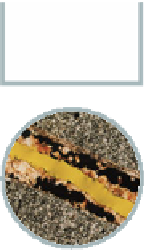Geoscience Reference
In-Depth Information
Roofing slate
3
new source (British Standards Institution, 2004). Once it
has been established that the material is suitable for
roofing applications, further testing of the factory
product is required at regular intervals for quality
assurance. Further testing is sometimes required by the
manufacturer, the purchaser, or third parties to
investigate nonconformities/complaints, confirm identity,
or to diagnose the causes of in-service failure.
It is a EN 12326-1 (British Standards Institution, 2004)
requirement that petrographic examination be performed
on slates from new sources as part of initial type testing
and at least annually (or every 25,000 tonnes if sooner)
for existing sources, as part of factory production
control. Additionally, petrography is identified as a
standard tool for the resolution of quality disputes.
Petrographic examination should be the first test carried
out to check that the rock is actually slate and decide
whether the product falls within the scope of EN 12326-
1 classification.
The standard suite of EN tests also includes assessment
of slate dimensions, bending strength, water absorption,
carbonate and noncarbonate carbon content, along with
a sulfur dioxide exposure test, and a thermal cycling test.
A full programme of examination, analysis, and testing
for factory production quality control requires
assessment of up to 100 whole slates. The slates for
assessment are selected at random from the production
run. When investigating in-service failure, a number of
slates would typically be removed from the roof. These
would usually be chosen to represent the range of slate
quality present, including both apparently defective
slates and apparently nondefective comparison samples.
In the USA, roofing slate is specified in accordance with
ASTM C406 (ASTM International. 2006), which covers the
material's characteristics, physical requirements, and
sampling requirements. The standard requires that
modulus of rupture, absorption, and depth of softening
tests are conducted on a set of representative slates.
Petrography is not currently a requirement of the standard.
Slate is a rock derived from fine-grained sediments
(mudstones or siltstones, or in some cases volcanic tuffs),
which have undergone low-grade metamorphism and
deformation as results of tectonic compression. Slate
comprises a high proportion of platy phyllosilicate
minerals that align during deformation, imparting a
cleavage to the rock along which it can be split into thin
sheets (slaty cleavage).
The ability to split slate along planes of cleavage
makes it suitable for use as a building material, in
particular a roofing material. Slate and other fissile rocks
have a long history of use in roofing and good roofing
slates have been known to survive on buildings for
hundreds of years.
Selected commercial applications of petrographic
examination to roofing slate investigation include:
• Initial suitability assessment of slate from new
sources.
• Routine quality assurance of slate from the factory
production run.
• Confirming the identity/quality of slate for
purchasers.
• Diagnosing the causes of in-service
deterioration/failure.
• Matching slate types for restoration of historic
buildings.
As with other natural stone resources, slate is variable in
character and testing is required as part of the quality
assurance for slate products. Testing requirements for
roofing slate are usually specified either by the EN or the
ASTM.
In Europe, to ensure that roofing slate is fit for
purpose, the CEN requires the manufacturer to undertake
a programme of initial type testing to evaluate the
composition, strength, and potential durability of every







